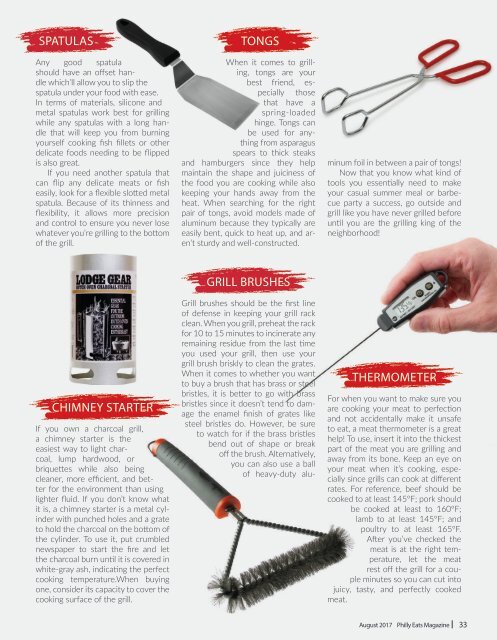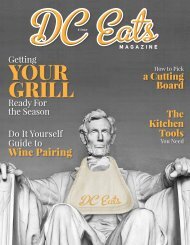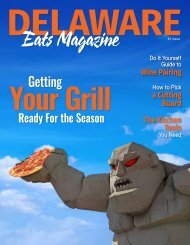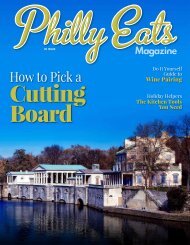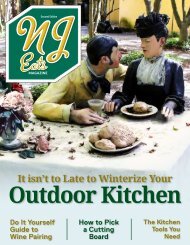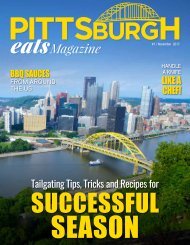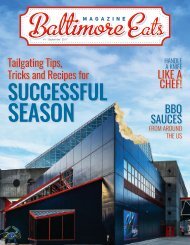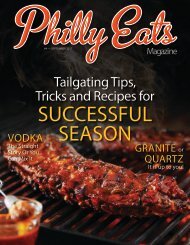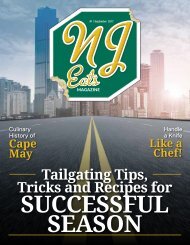Philly Eats Third Edition 2017
Philly Eats Magazine August Edition is full of fine recipes and tips.
Philly Eats Magazine August Edition is full of fine recipes and tips.
Create successful ePaper yourself
Turn your PDF publications into a flip-book with our unique Google optimized e-Paper software.
SPATULAS<br />
Any good spatula<br />
should have an offset handle<br />
which’ll allow you to slip the<br />
spatula under your food with ease.<br />
In terms of materials, silicone and<br />
metal spatulas work best for grilling<br />
while any spatulas with a long handle<br />
that will keep you from burning<br />
yourself cooking fish fillets or other<br />
delicate foods needing to be flipped<br />
is also great.<br />
If you need another spatula that<br />
can flip any delicate meats or fish<br />
easily, look for a flexible slotted metal<br />
spatula. Because of its thinness and<br />
flexibility, it allows more precision<br />
and control to ensure you never lose<br />
whatever you’re grilling to the bottom<br />
of the grill.<br />
TONGS<br />
When it comes to grilling,<br />
tongs are your<br />
best friend, especially<br />
those<br />
that have a<br />
spring-loaded<br />
hinge. Tongs can<br />
be used for anything<br />
from asparagus<br />
spears to thick steaks<br />
and hamburgers since they help<br />
maintain the shape and juiciness of<br />
the food you are cooking while also<br />
keeping your hands away from the<br />
heat. When searching for the right<br />
pair of tongs, avoid models made of<br />
aluminum because they typically are<br />
easily bent, quick to heat up, and aren’t<br />
sturdy and well-constructed.<br />
Grill brushes should be the first line<br />
of defense in keeping your grill rack<br />
clean. When you grill, preheat the rack<br />
for 10 to 15 minutes to incinerate any<br />
remaining residue from the last time<br />
you used your grill, then use your<br />
grill brush briskly to clean the grates.<br />
When it comes to whether you want<br />
to buy a brush that has brass or steel<br />
bristles, it is better to go with brass<br />
bristles since it doesn’t tend to damage<br />
the enamel finish of grates like<br />
steel bristles do. However, be sure<br />
to watch for if the brass bristles<br />
bend out of shape or break<br />
off the brush. Alternatively,<br />
you can also use a ball<br />
of heavy-duty aluminum<br />
foil in between a pair of tongs!<br />
Now that you know what kind of<br />
tools you essentially need to make<br />
your casual summer meal or barbecue<br />
party a success, go outside and<br />
grill like you have never grilled before<br />
until you are the grilling king of the<br />
neighborhood!<br />
CHIMNEY STARTER<br />
If you own a charcoal grill,<br />
a chimney starter is the<br />
easiest way to light charcoal,<br />
lump hardwood, or<br />
briquettes while also being<br />
cleaner, more efficient, and better<br />
for the environment than using<br />
lighter fluid. If you don’t know what<br />
it is, a chimney starter is a metal cylinder<br />
with punched holes and a grate<br />
to hold the charcoal on the bottom of<br />
the cylinder. To use it, put crumbled<br />
newspaper to start the fire and let<br />
the charcoal burn until it is covered in<br />
white-gray ash, indicating the perfect<br />
cooking temperature.When buying<br />
one, consider its capacity to cover the<br />
cooking surface of the grill.<br />
GRILL BRUSHES<br />
THERMOMETER<br />
For when you want to make sure you<br />
are cooking your meat to perfection<br />
and not accidentally make it unsafe<br />
to eat, a meat thermometer is a great<br />
help! To use, insert it into the thickest<br />
part of the meat you are grilling and<br />
away from its bone. Keep an eye on<br />
your meat when it’s cooking, especially<br />
since grills can cook at different<br />
rates. For reference, beef should be<br />
cooked to at least 145ºF; pork should<br />
be cooked at least to 160ºF;<br />
lamb to at least 145ºF; and<br />
poultry to at least 165ºF.<br />
After you’ve checked the<br />
meat is at the right temperature,<br />
let the meat<br />
rest off the grill for a couple<br />
minutes so you can cut into<br />
juicy, tasty, and perfectly cooked<br />
meat.<br />
August <strong>2017</strong> <strong>Philly</strong> <strong>Eats</strong> Magazine 33


